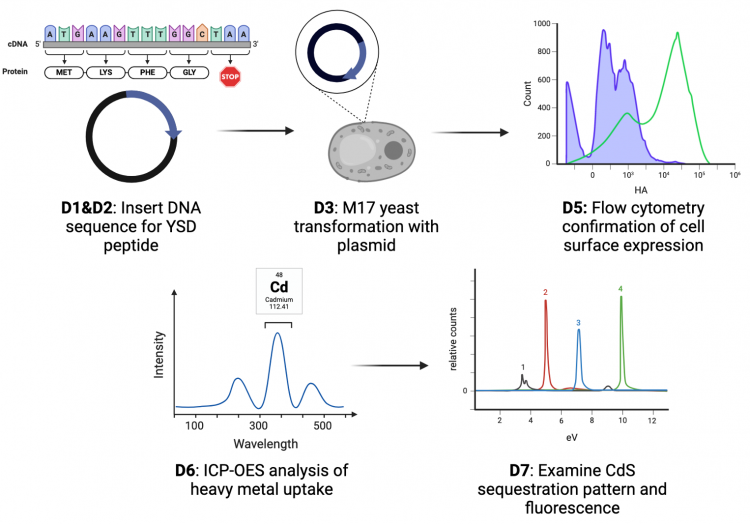Difference between revisions of "20.109(S24):Module 2"
Becky Meyer (Talk | contribs) |
Becky Meyer (Talk | contribs) (→Lab links: day by day) |
||
| Line 22: | Line 22: | ||
==Lab links: day by day== | ==Lab links: day by day== | ||
| − | M2D1: [[20.109(S24):M2D1 |Determine | + | M2D1: [[20.109(S24):M2D1 |Determine peptide design strategy]] <br> |
| − | M2D2: [[20.109(S24):M2D2 | | + | M2D2: [[20.109(S24):M2D2 |Clone cell surface peptide display plasmid]] <br> |
| − | M2D3: [[20.109(S24):M2D3 |Sequence clones and transform into yeast | + | M2D3: [[20.109(S24):M2D3 |Sequence clones and transform into yeast]] <br> |
| − | M2D4: [[20.109(S24):M2D4 | | + | M2D4: [[20.109(S24):M2D4 |Align sequencing and prepare for Journal Article presentations]] <br> |
| − | M2D5: [[20.109(S24):M2D5 | | + | M2D5: [[20.109(S24):M2D5 |Perform flow cytometry and harvest cells to test cadmium sequestration]] <br> |
| − | M2D6: [[20.109(S24):M2D6 | | + | M2D6: [[20.109(S24):M2D6 |Quantify cadmium removal from media]] <br> |
| − | M2D7: [[20.109(S24):M2D7 | | + | M2D7: [[20.109(S24):M2D7 |Visualize cadmium sequestration and assess quality of cadmium sulfide production]] <br> |
| − | M2D8: [[20.109(S24):M2D8 |Complete data analysis and organize Research | + | M2D8: [[20.109(S24):M2D8 |Complete data analysis and organize Research Article figures]] <br> |
==Major assignments== | ==Major assignments== | ||
Revision as of 19:57, 28 February 2024
Contents
Module 2: protein engineering
Heavy metal environmental contamination is an increasing concern. Heavy metals are released into the environment during activities like mining and fertilizer release in farming. Additionally, heavy metals are released into the environment from the disposal of electronic waste. As such, the ability to remove the metal contamination from soil and water is a topic of great interest.
One way to approach this problem is by harnessing known biological mechanisms and repurpose them to clean environmental pollution. This is known as bioremediation. In this module, we will use protein engineering to attempt to create a model system for bioremediation by taking advantage of a genetically tractable model organism Saccharomyces cerevisiae (baker's yeast). We will be utilizing a version of this organism that has been genetically modified to produce hydrogen sulfate, which will precipitate cadmium in the media.
Our aim in Mod 2 is to use this strain of hydrogen sulfide producing yeast and engineer a cell surface display system to display a peptide of your design in order to capture precipitating cadmium. We will then assess the quantity of cadmium captured as well as it's quality for recycling back into the manufacturing process.
Research goal: Genetically engineer a cell surface display peptide to capture cadmium in a model for bioremediation
Lab links: day by day
M2D1: Determine peptide design strategy
M2D2: Clone cell surface peptide display plasmid
M2D3: Sequence clones and transform into yeast
M2D4: Align sequencing and prepare for Journal Article presentations
M2D5: Perform flow cytometry and harvest cells to test cadmium sequestration
M2D6: Quantify cadmium removal from media
M2D7: Visualize cadmium sequestration and assess quality of cadmium sulfide production
M2D8: Complete data analysis and organize Research Article figures
Major assignments
Journal article presentation
Research article

